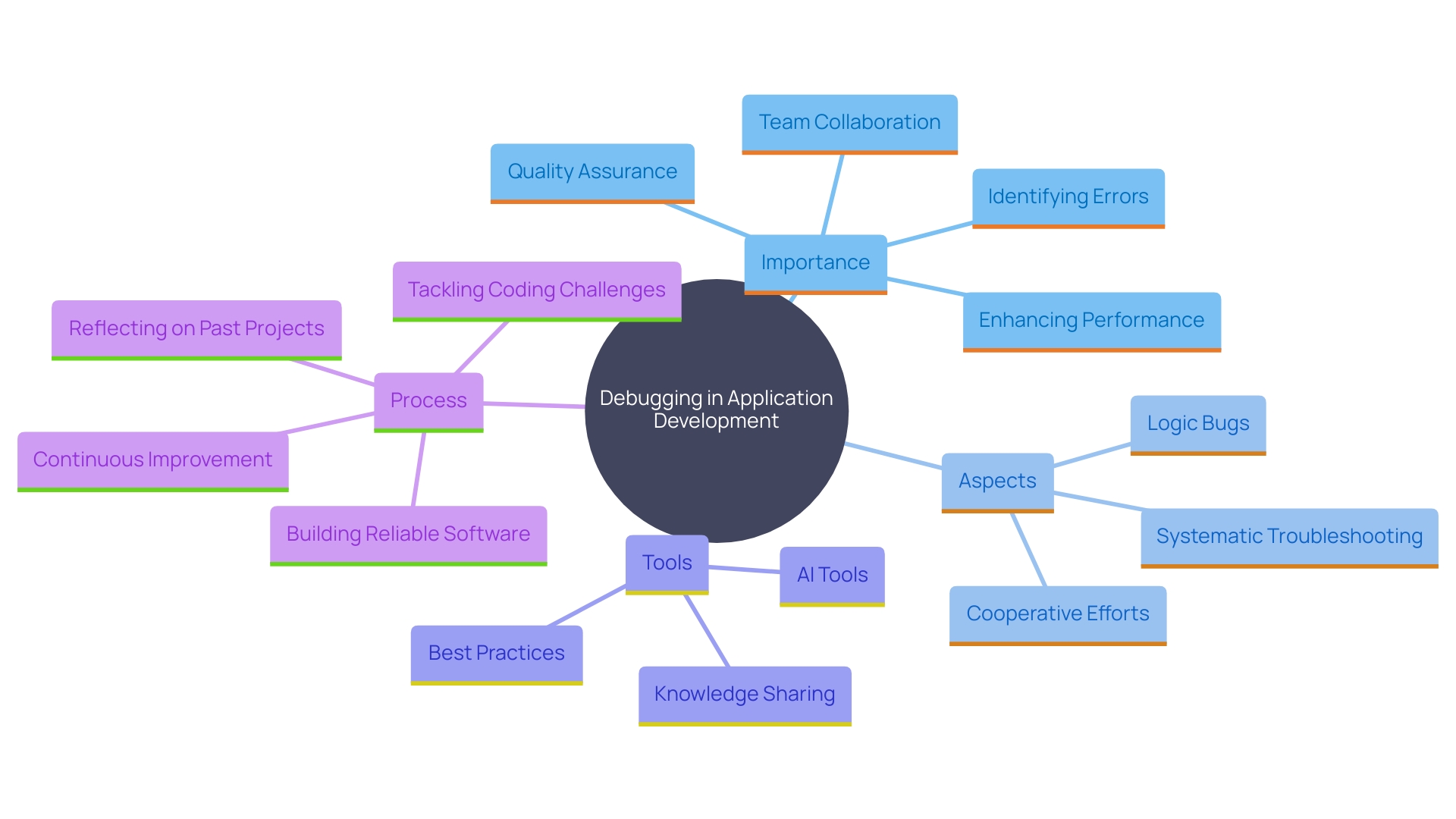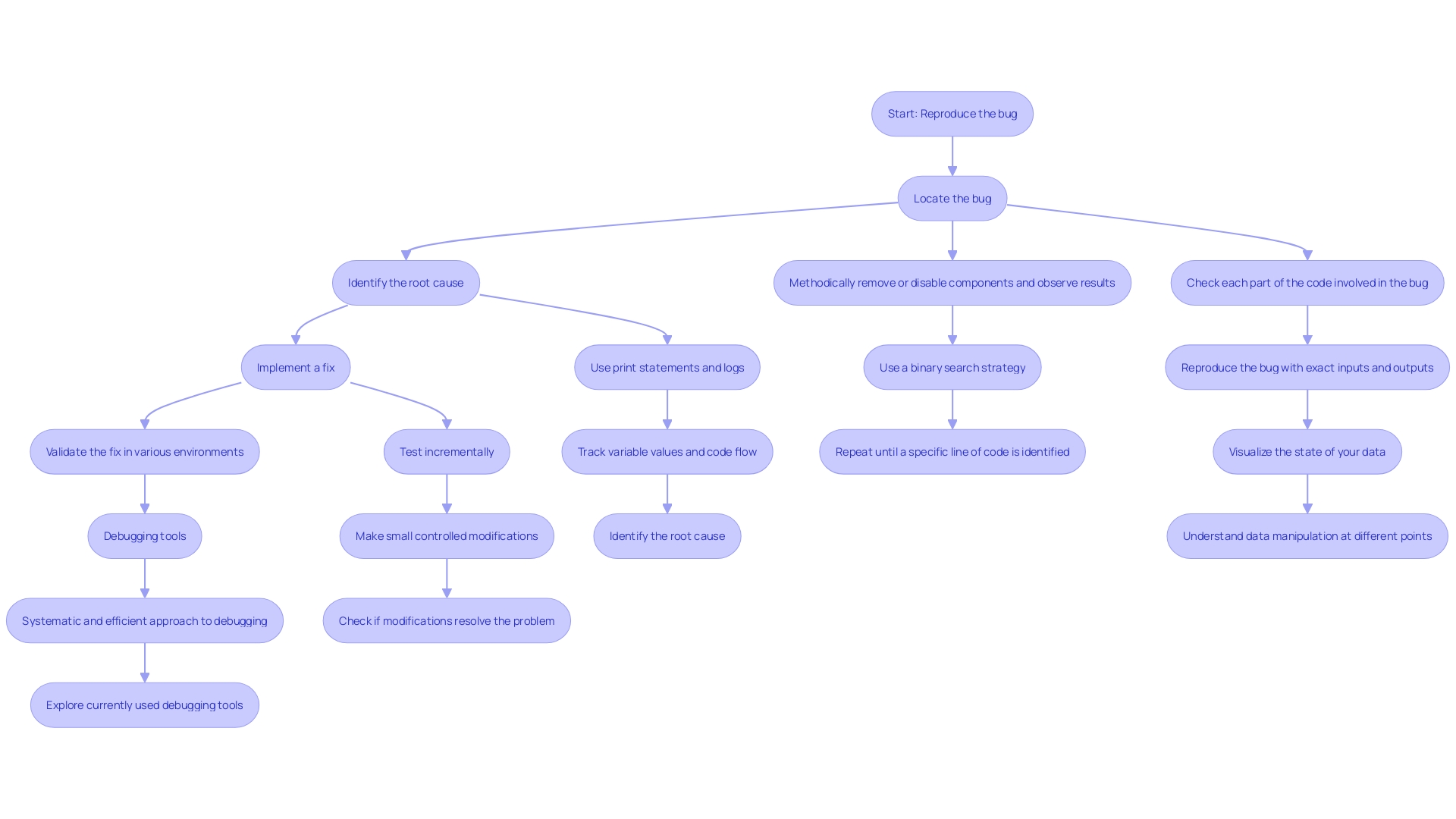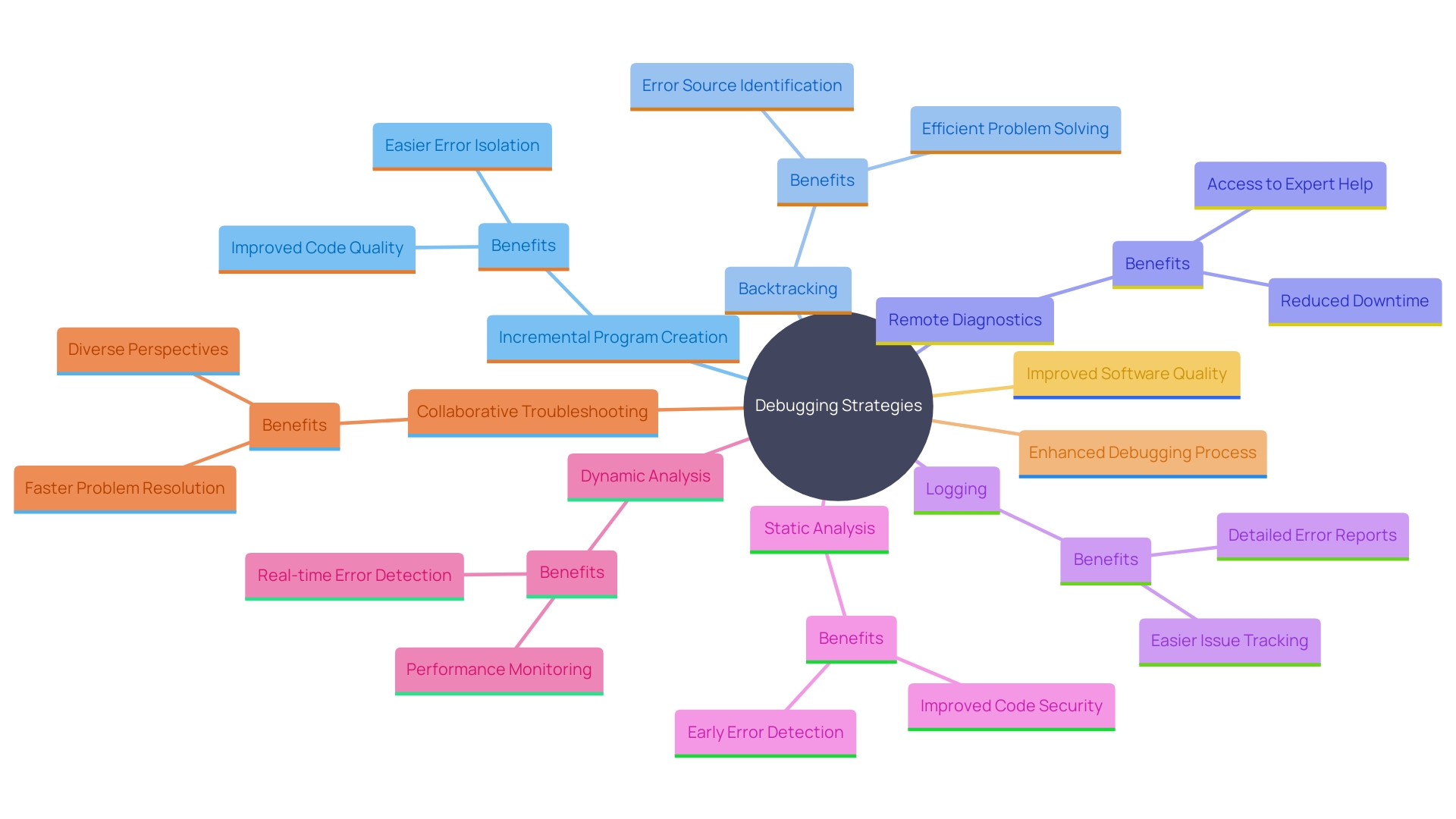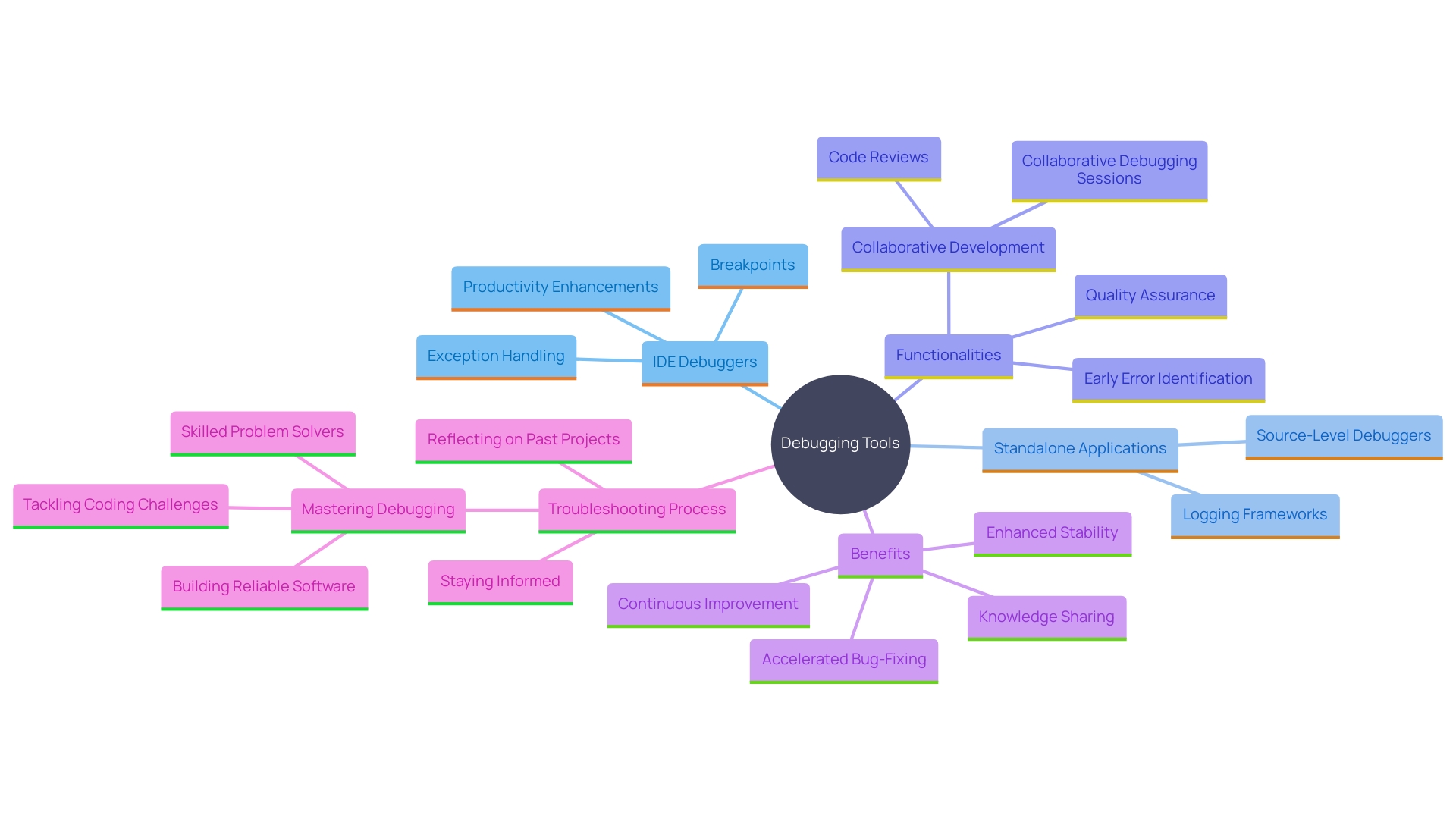Introduction
In the fast-paced world of software development, ensuring maximum efficiency and productivity is paramount. One of the most critical tools in achieving this goal is a debugger. Debuggers provide developers with the ability to scrutinize and control the execution of their programs, allowing for a meticulous examination of code to identify and resolve issues.
By isolating bugs and monitoring program behavior, these powerful utilities foster a deeper understanding of component interactions during runtime, ultimately enhancing software stability and reliability. With advancements like breakpoint groups and live probes, the debugging experience has become more intuitive and efficient, empowering developers to tackle the complexities of modern software development head-on. This article delves into the importance of debugging, the systematic approach to the debugging process, common strategies, essential tools, and the numerous benefits that effective debugging brings to the table.
What is a Debugger?
A debugger serves as an essential tool in program development, enabling a comprehensive examination of a program's execution. This powerful utility allows developers to inspect and manipulate the state of an application, facilitating the identification and resolution of code issues. By offering a controlled environment, debuggers help isolate bugs, monitor program behavior, and understand component interactions during runtime. Debugging not only enhances productivity but also contributes to the overall stability and reliability of software. 'Recent advancements, like the introduction of breakpoint groups and live probes, have significantly enhanced the troubleshooting experience.'. For instance, Visual Studio's 2023 updates have streamlined debugging tasks, making them more intuitive and efficient, as highlighted by the feedback from the developer community. Adopting these tools and methods is crucial for managing the intricacies of contemporary programming.
Why is Debugging Important?
Debugging is a cornerstone of application development, playing a vital role in ensuring the reliability and stability of programs. It involves the systematic process of identifying and resolving errors that disrupt the normal operation of applications. Efficient troubleshooting not only boosts performance and user contentment but greatly elevates the overall standard of the application.
The importance of debugging is underscored by the fact that developers, being human, are prone to making mistakes. These errors need to be addressed promptly to prevent them from escalating into more complex issues that are harder to resolve. Debugging helps in the early identification of issues, which is essential for ensuring a seamless application creation process. This process involves pinpointing the underlying reasons for errors and ensuring the system operates properly after the correction.
Additionally, troubleshooting aids in the application creation process by enabling faster cycles and revisions. It helps in catching logic bugs that can have devastating impacts if left unchecked. This is especially crucial as logic errors can impact essential computer systems that support almost every computing device.
In cooperative creation settings, troubleshooting becomes a collective task. Team members participate in code evaluations and cooperative troubleshooting sessions, combining their expertise to improve the application's stability. This not only accelerates the bug-fixing process but also fosters a culture of knowledge sharing and continuous improvement within the development team.
Statistics indicate that more than 750,000 accident reports and input from 18 software engineers and team leaders emphasized the significance of troubleshooting in preserving software quality. 'Furthermore, AI pair-programming tools such as GitHub Copilot have greatly influenced programmer efficiency by helping with immediate code completion, thereby facilitating the error correction process.
In summary, troubleshooting is a crucial and continuous aspect of the Software Development Life Cycle (SDLC). It is an essential ability for programmers, necessitating a blend of resources, tactics, and a methodical strategy to recognize and address problems within applications.

The Debugging Process
The troubleshooting process involves a methodical sequence of steps designed to identify and resolve software issues efficiently. Initially, programmers must reliably reproduce the bug, ensuring they can consistently observe the problem. This step is crucial, as it lays the foundation for all subsequent actions. Once the bug is reproducible, the next step is to pinpoint its location within the codebase. This often requires analyzing logs — which provide a historical record of events — or using breakpoints to inspect the application state at critical moments.
Locating the bug is just the beginning. Developers must then delve deeper to identify the root cause, which often involves understanding the complex interactions within the code. This step is akin to solving a puzzle, where each piece of information gathered through tools like logging frameworks and integrated debuggers helps form a complete picture. Logging, for instance, offers insights into errors and exceptions, making it easier to trace issues that arise, especially in production environments.
After identifying the root cause, the next step is to implement a fix. This solution must be validated rigorously to ensure it resolves the issue without introducing new problems. Code reviews play a pivotal role here, fostering a collaborative environment where team members can learn from each other and enhance the overall quality of the codebase. As per a research, developers noted that the accuracy of proposed error-prone files was approximately 80%, emphasizing the significance of organized methods in error correction.
Finally, it's essential to validate the fix in various environments to ensure the bug is genuinely resolved. This thorough method for troubleshooting not only tackles the immediate problem but also aids in creating strong and dependable systems. As one expert states, 'Armed with the knowledge, tools, and best practices outlined in this guide, you'll be well-equipped to tackle any coding challenge and create applications that stand the test of quality and reliability.'. Happy debugging!'

Common Debugging Strategies
Debugging encompasses several strategies that can significantly streamline the process of identifying and resolving software issues. Incremental program creation, for instance, involves building code in small, testable increments. This approach simplifies the detection of issues early in the development cycle, enhancing overall code quality. Backtracking is another effective technique that allows programmers to trace their steps and pinpoint where things went wrong, thus facilitating quicker problem resolution.
Remote diagnostics proves invaluable when troubleshooting applications running in different environments. It enables programmers to diagnose issues on remote systems without physical access, thereby saving time and resources. Furthermore, logging is an essential troubleshooting technique where programmers add print statements to observe the execution flow of the program. This technique helps verify whether specific blocks of code are executing as intended and is particularly useful when dealing with complex logic.
Static analysis tools play a crucial role by examining code without executing it, identifying potential errors and vulnerabilities. Dynamic analysis, on the other hand, involves executing the code and monitoring its behavior to detect runtime issues. Collaborative troubleshooting, where multiple developers work together to solve problems, can also enhance the troubleshooting process by leveraging collective expertise and different perspectives.
Integrating these methods not only enhances the effectiveness of troubleshooting but also increases overall productivity. Considering recent progress, tools like Visual Studio have introduced features such as Breakpoint Groups to minimize repetitive tasks, further enhancing the troubleshooting experience. This evolution in debugging tools, propelled by ongoing input from the programming community, highlights the significance of utilizing a multifaceted strategy to debugging for attaining higher software quality.

Debugging Tools and Techniques
Debugging tools are essential for programmers aiming to enhance their troubleshooting capabilities. These tools range from integrated development environment (IDE) debuggers to standalone applications, each offering unique functionalities. 'IDE debuggers, for example, allow programmers to set breakpoints, inspect variables, and step through code, making it easier to identify and resolve issues.'. Familiarity with various types of debuggers, including source-level and memory debuggers, significantly boosts a programmer's efficiency.
Integrated debuggers often provide the ability to catch exceptions as they occur, allowing programmers to inspect the state of the application at the time of the exception. This feature is especially advantageous in grasping the context of mistakes in JavaScript code, thereby simplifying the troubleshooting process and enhancing user experience. Based on a recent study, programmers have discovered that the accuracy of tools in detecting faulty files can be approximately 80%, emphasizing the efficiency of contemporary error-fixing solutions.
Logging frameworks further complement debuggers by tracking events, errors, and application behavior over time. This historical context is crucial for tracing issues that arise in production environments. By logging errors and exceptions, programmers can gain insights into user-reported issues, even if they cannot reproduce the problem locally. This dual approach of using debuggers and logging not only improves the troubleshooting process but also ensures a stable and reliable application, which is key to user satisfaction.
Recent updates in Visual Studio have introduced features like Breakpoint Groups, which minimize the need for repetitive scrolling and toggling of individual breakpoints, thus significantly boosting productivity. These improvements demonstrate the ongoing work to enhance and streamline the troubleshooting process, making it more effortless and user-friendly for programmers.
In conclusion, mastering the use of various troubleshooting tools and techniques is essential for any developer. Whether addressing syntax mistakes, logical issues, or unforeseen code interactions, a methodical approach to troubleshooting can result in more efficient and effective software creation.

Benefits of Effective Debugging
Effective debugging provides numerous benefits that extend far beyond simply fixing errors. By systematically identifying and resolving issues, developers can significantly reduce the time spent on creation and maintenance, leading to increased efficiency and productivity. This proactive strategy guarantees that coding mistakes are identified early in the creation process, preventing them from escalating into more complex and costly issues.
Debugging serves as a crucial mechanism for quality assurance, ensuring that the final product meets the intended specifications. It contributes to the overall efficiency and effectiveness of the coding process, making applications more robust and reliable under various conditions. 'This is especially crucial in web design, where bugs can disrupt the user experience, causing frustration and disengagement.'.
Furthermore, troubleshooting encourages a culture of quality and ongoing enhancement among programming groups. Joint problem-solving sessions and code evaluations enable team members to combine their knowledge, speeding up the bug-fixing process and improving the software's stability. This shared activity not only improves individual projects but also promotes knowledge sharing and drives collective progress within the team.
In a collaborative development setting, troubleshooting becomes a shared responsibility. Team members participate in code reviews and cooperative troubleshooting sessions, which not only speeds up the bug-fixing process but also promotes a culture of knowledge sharing and ongoing enhancement. This collaborative approach enhances the software's stability and ensures that the final product meets the intended specifications.
Integrating crucial troubleshooting methods, like utilizing print statements to monitor the execution flow of a program, is essential for programmers at every stage. These techniques can be utilized across different programming languages and frameworks, rendering them adaptable instruments for enhancing code quality and programmer productivity. As research has shown, AI-powered tools like GitHub Copilot can further enhance debugging efficiency by providing useful suggestions and reducing cognitive load, ultimately leading to better outcomes for both developers and organizations.
Conclusion
Effective debugging is an essential component of successful software development, offering a multitude of benefits that enhance productivity and software quality. By systematically identifying and resolving issues, developers can minimize the time spent on troubleshooting, allowing for quicker iterations and updates. This proactive approach to debugging not only addresses coding errors early in the development process but also prevents them from escalating into more complex problems that can hinder project timelines and budgets.
Moreover, debugging plays a pivotal role in ensuring the reliability and stability of applications. It serves as a quality assurance mechanism that enables developers to deliver software that meets intended specifications and provides a seamless user experience. In collaborative environments, debugging fosters a culture of shared responsibility and continuous improvement, where team members work together to enhance code quality and stability, ultimately leading to more robust applications.
The integration of advanced debugging tools and techniques further amplifies these benefits. With innovations such as breakpoint groups and AI-assisted coding tools, the debugging process has become more intuitive and efficient. These advancements empower developers to tackle the complexities of modern software development effectively, ensuring that they can focus on creating high-quality, reliable software solutions that meet user needs.
Embracing effective debugging practices is not just a technical necessity; it is a strategic advantage that drives success in the competitive landscape of software development.
Frequently Asked Questions
What is the purpose of a debugger?
A debugger is a tool that allows developers to examine a program's execution, inspect and manipulate its state, and identify and resolve code issues. It creates a controlled environment to isolate bugs and monitor program behavior during runtime.
Why is debugging important in application development?
Debugging is crucial because it helps ensure the reliability and stability of software by systematically identifying and resolving errors that disrupt normal operation. It enhances productivity and contributes to software quality.
How does debugging improve software quality?
Debugging helps detect and address coding mistakes early in the development process, preventing them from escalating into more complex issues. This proactive approach ensures that applications are robust and reliable.
What are some recent advancements in debugging tools?
Recent advancements include features like breakpoint groups and live probes, which enhance the debugging experience by making tasks more intuitive and efficient. For example, updates in Visual Studio have streamlined debugging tasks significantly.
What is the typical process of troubleshooting a bug?
The troubleshooting process involves several steps: reproducing the bug to ensure it can be observed consistently, pinpointing its location in the codebase using tools like logs and breakpoints, identifying the root cause by analyzing interactions within the code, and implementing and validating a fix, followed by thorough testing in various environments.
What techniques can enhance the debugging process?
Techniques that can facilitate debugging include incremental program creation, which builds code in small, testable increments; backtracking to trace steps and identify where issues occurred; remote diagnostics for diagnosing applications in different environments; and logging to track execution flow and identify errors.
How do logging frameworks assist in debugging?
Logging frameworks track events, errors, and application behavior over time, providing historical context that is crucial for tracing issues in production environments. They help developers gain insights into problems even if they cannot reproduce them locally.
What role does collaboration play in debugging?
In collaborative development settings, team members participate in code reviews and joint troubleshooting sessions. This collective effort not only speeds up the bug-fixing process but also fosters knowledge sharing and continuous improvement within the development team.
How can AI tools impact debugging efficiency?
AI-powered tools, such as GitHub Copilot, can enhance debugging efficiency by assisting with immediate code completion and providing useful suggestions, which reduces cognitive load and helps developers achieve better outcomes.
What is the overall significance of debugging within the Software Development Life Cycle (SDLC)?
Debugging is a continuous and crucial aspect of the SDLC, requiring a blend of resources, strategies, and a systematic approach to effectively recognize and resolve issues within applications, ultimately leading to higher software quality and user satisfaction.




